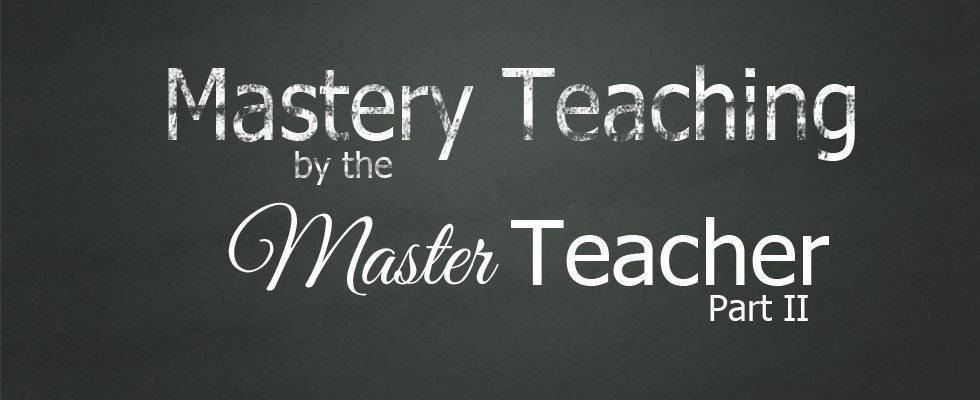Learning to Teach as Jesus Taught
Please read John, chapters 13-17.
We are taking a look at the last conversation Jesus had with His disciples, at the Last Supper, and on the way to the Garden of Gethsemane. These chapters record the very important lessons that Christ wanted His followers to know before He left them. Throughout this conversation, we see Jesus, the Master Teacher, and how he treats questions from several different personality types.
We have discussed Peter, the Distracted Student. A natural leader, he was always losing focus, changing the subject, and making everything about himself. Let’s take a look at another type of student. The next disciple to speak in this conversation was Thomas.
John 14:2-7, “In my Father’s house are many mansions: if it were not so, I would have told you. I go to prepare a place for you. And if I go and prepare a place for you, I will come again, and receive you unto myself; that where I am, there ye may be also. And whither I go ye know, and the way ye know. Thomas saith unto him, Lord, we know not whither thou goest; and how can we know the way? Jesus saith unto him, I am the way, the truth, and the life: no man cometh unto the Father, but by me. If ye had known me, ye should have known my Father also: and from henceforth ye know him, and have seen him.”
THE QUESTIONING STUDENT
Thomas, it seems to me, was a skeptic. He had a question for every answer. Jesus was comforting Peter by telling him about Heaven. He had had this discussion with His followers before. Immediately Thomas corrects Him. “Teacher, we don’t know what you’re talking about! How can we know to solve the problem?”
As a teacher, I would be very interested to know Thomas’ background. There is always that student in class that is ready to correct the teacher at any moment. He doesn’t raise his hand, but yells out, “A test? You never told us there was a test! You never gave us all the notes.” This student can try a teacher’s patience as he seems to blame the teacher for everything. A mature teacher does not take this student’s accusations personally. Yes, he can seem disrespectful. Yes, he can REALLY get on your nerves. But this student has trust issues. They may not have anything to do with you. Imagine if you teach a child whose parent walked out on him. He is going to always doubt what you day a little. If you get frustrated with him, he’ll never give you his trust. He needs stability. He may simply be one of many children in a large family who is seeking extra one-on-one attention. He may feel ignored.
Jesus said that the disciples knew where He was going and how to get there. Of course they knew. This was the main topic of all His teachings over the last 3 years. This was the reason He came, so that people could be saved and join him in Heaven. This information was not a surprise. Yet, because Thomas did not understand, or perhaps He just lacked the faith to believe that is would actually happen, he tried to make it seem that this was new information that had not been explained.
The Master Teacher shows us how to handle this student. Calm, clear, explanation. Jesus explained the answer to Thomas’ question without flying off the handle. Surely after 3 years of having Thomas as a student, Christ was used to these questions from him. He did correct Thomas after he answered his question by saying, “If you had been paying attention, you would have known this. Please pay attention from now on.” If ye had known me, ye should have known my Father also: and from henceforth ye know him, and have seen him.
Even after Jesus rose from the dead, Thomas didn’t believe that the other disciples saw him. Once again, when Christ appeared to him, He assured Thomas once again.
John 20:25, “But Thomas, one of the twelve, called Didymus, was not with them when Jesus came. The other disciples therefore said unto him, We have seen the Lord. But he said unto them, Except I shall see in his hands the print of the nails, and put my finger into the print of the nails, and thrust my hand into his side, I will not believe. And after eight days again his disciples were within, and Thomas with them: then came Jesus, the doors being shut, and stood in the midst, and said, Peace be unto you. Then saith he to Thomas, Reach hither thy finger, and behold my hands; and reach hither thy hand, and thrust it into my side: and be not faithless, but believing. And Thomas answered and said unto him, My Lord and my God. Jesus saith unto him, Thomas, because thou hast seen me, thou hast believed: blessed are they that have not seen, and yet have believed. ”
Yes, Thomas was a doubter, a skeptic. He had to SEE things for himself. We don’t know what in his life had caused these trust issues. But we can learn from Christ’s example, that we should be patient and kind with this student, and we should show the student the answer….again……and again. Eventually they will trust what we say, when they know we love them and believe in them. Jesus surrounded Himself with “hard cases.” Sometimes the students who will do the greatest things in the future will be the most difficult to work with, and will require the most patience.







This design is spectacular! You obviously know how to keep a reader amused. Between your wit and your videos, I was almost moved to start my own blog (well, almost…HaHa!) Great job. I really enjoyed what you had to say, and more than that, how you presented it. Too cool!
Wonderful content and wonderful webpage. Pleased I discovered this while browsing hash tags on Instagram.